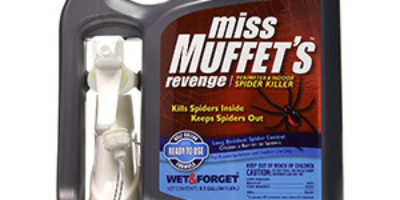Contents
We are supported by our readers. When you buy through links on our site, we may earn an affiliate commission at no additional cost to you.
Rats are the most common mammals on earth and they usually forage in packs. Spotting a mouse, no matter how small, shows a good probability of finding others hiding in other secretive areas of your house, garage, business premise, and even farms. Here is a combined workforce of intellectuals coming together to deliver diverse and factual information about mice and rats, including rat trap reviews about the best rat trap list and comparisons of the best mouse trap methods that are available in the market. They are known to be fond of causing significant damages where they inhabit. We take a step in an attempt to help you in your actions towards rats and mice control.
Best Mouse Trap Reviews – Top 5
[go_pricing id=”mousetrap”]1. CaptSure – Best Humane Mouse Trap
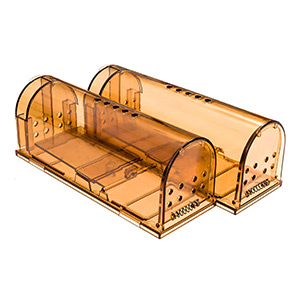
CaptSure smart catch and release trap only traps the mouse in it but does no killing. It has a spring door which promptly closes once a mouse makes its way into the trap, to get the placed bait.
In addition, it has ventilation holes giving the mouse breathing air flow when captured. It works without poison, toxins, or glue, therefore, it’s safe to place it at home near children or pets. It is highly recommended for all sizes of mice. It’s also available in two sizes.
Easy to use and reuse as all you are required to do is to position and place a dash of peanut butter and let the mice in. Afterward, once a mouse is caught, you release them outside far away from your resident or business premises. However, release them at least a couple of miles away from your home. Otherwise, they could find their way back.
Pros:
- Extremely humane, no-kill, no pain. Supported by humane societies and animal rights organizations.
- Safe to use around children and pets whether it’s indoor or outdoor.
- Easy to use with a sensitive and see-through design.
- Carefully designed to avoid touch or stuck finger accidents.
Cons:
- If you let the mice stay in the trap for long, they may be able to bite their way out through the plastic latch.
- Cleaning is not a very easy process specially if the mice poop inside.
2. AB Traps Pro-Quality – Best Live Catch Rat Trap
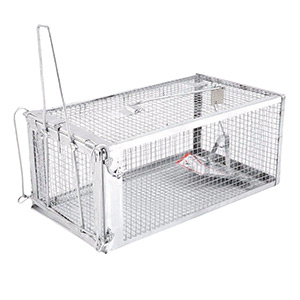
AB Pro-Quality live catch humane trap come readily assembled for use. This catch and release rat trap neither kill nor causes any injury to rats, mice, and other rodents. It is safe as it needs no poison, spray, electricity, or glue. Use it with no worry where there are children or pets.
Just put the bait such as peanut butter inside the trap and wait to see it work. It can be used both indoors and outdoors. It sets up and locks rats in within minutes when placed correctly where rodents roam.
The trap comes in different sizes and they are reusable for a good period of time. Made with strong material, all assembled, and ready for use. It is also constructed with a wire like cage so the catch will have plenty of air flow to breath. Engineered with very high success rate. Once in, rodents cannot leave until removed.
Pros:
- An effective catch and release mouse and rat trap, that gives the catch plenty of room to breath and move.
- Unlike plastic catch and release traps, this trap has a wire mesh that makes it harder for the rat to escape.
- Safe for children and pets as it uses no poison or electricity.
- One of the best ways to bait and trap wild rats in the most humane possible way.
Cons:
- The bar for tripping the trap becomes loose after a couple of uses which makes it hard to set the trap.
- Some larger rodents manage to damage the wire mesh. As a result, we recommend that you get the appropriate trap size for rodent you are trying to catch.
3. Tomcat Press N’ Set – Best Rat Trap
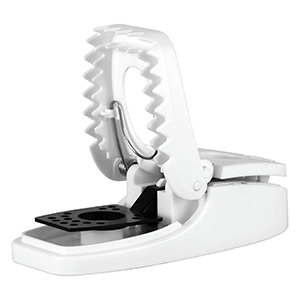
With an ease of usage, it conveniently grabs and kills mice. It has an inbuilt grab-tab purpose for easy disposal. Setting the trap is quick. It is simply a touch away. With its sleek and aggressive design, it comes with a more responsive and precise trigger mechanism.
It features an integrated bait cup to hold the bait, providing better results. You can use it in line with the Tomcat attractant gel or other types of baits. Once you identify the type of rodent that keeps giving you trouble, bait or use the gel and press to set it. Then place it in an active runway or other appropriate locations where you noticed mouse activity.
It is also washable and it will not lock in odor and stains. Tomcat lets you see the dead mouse once caught and then you can easily snap it for disposal of the mouse.
Pros:
- Easy to use, it allows you to bait before setting the trigger, thus, eliminating mis-triggering, making it more finger friendly.
- Easy to dispose of the caught mouse after use without touching by using the grab tab.
- Offers increased capturing power with no false triggers.
- It guarantees to kill the mouse once trapped.
Cons:
- Requires close watch as it is not safe for pets.
- The trigger arm might not get set correctly after 3 or 4 uses.
4. Victor Power Kill Snap – Best Mouse Trap
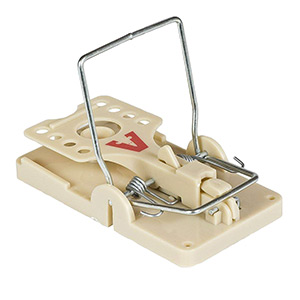
Made with durable plastic and rigid steel, comes this long-lasting mousetrap. It’s significantly advanced compared to the traditional wooden traps, resisting stains and odors. This newer version has a vertical trigger which travels a lesser distance, leaving no time for the rat to escape.
The Victor power kill trap can also be used for catching different kinds of small rodents indoor or outdoor. Its extra-large trip paddle and strike bar ensures that the mouse gets caught from any direction whether it’s from the front, back, or sides. It catches mice so quick, they can’t escape.
Easy to set up with just one click open and close action that lets you easily and cleanly dispose of the rodent without touching the body or risking your fingers. Baiting also becomes easy with its in-built bait cup. It’s easy and safe to use, apart from being sanitary.
Pros:
- Due to its strong structure, it’s durable and can be reused many times.
- Unlike conventional wooden snap rat traps, it leaves no odor or stain.
- A quick response time for its release mechanism making certain that once the rat gets caught, it stays caught.
- The metal trigger ensures a quick humane kill with no chance to escape.
Cons:
- It’s mainly designed for small rats and mice.
- Setup can be complicated and if you do not set it up perfectly, it won’t trigger.
5. Hoont – Best Electronic Mouse Trap
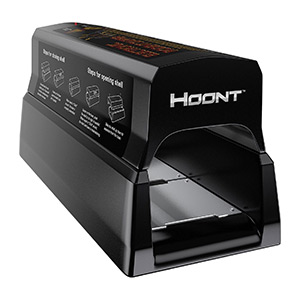
This is the best electronic rat zapper equipped with advanced detection technology to ensure an instant humane kill. It’s reusable and simple. It works by using a wall plug adapter or a set of 4D batteries to deliver a high voltage shock of 7000 volts to any rodent.
All you are supposed to do is place a bait or a small piece of peanut butter in the trap, turn it on and place it in areas where you see rodent activity then wait for it to do the rest. It ensures an instant humane kill without any possibility of escaping.
In addition, it enables you to check for trapped rats without the need to check the actual device through an indicator light and a low tone beep. With just one set of batteries, it can kill up to 30 rats. It may also accommodate a number of rats. However, going for one at a time is advisable.
Pros:
- Non-toxic, leaves no blood, no mess, and is reusable. 7000-volt high voltage shock that kills rats in seconds.
- A multi-catch rat trap, capable of catching rats in masses as long as it’s plugged into electricity or as far as the batteries go.
- It boasts an auto-reset mechanism which makes the trap always ready to kill.
- No touching required, simply pick up the trap and slide the exterminated rat into the trash bin. Then place the trap back to its location ready for its next catch.
Cons:
- The trap needs better instructions. The reason is in order for the trap to work, the bait has to be placed at the last plate. Otherwise, there will be no kill.
- If reused before cleaning then rodents might avoid it. Thus, it requires cleaning before reuse.
Best Mouse Trap Comparison
| Product/Feature | Type | Size | Pet-Friendly | Targets |
|---|---|---|---|---|
| CAPTSURE | Humane Trap | 6.7 x 2.5 x 2.4 inches | Yes | Rats + Mice |
| AB TRAPS | Humane Trap | 10.5 x 5.5 x 4.5 inches | Yes | Rats + Mice + Squirrels |
| TOMCAT PRESS N’ SET | Snap Trap | 1.5 x 6 x 4.5 inches | No | Rats + Mice |
| VICTOR POWER KILL SNAP | Snap Trap | 3.9 x 1.9 x 1.8 inches | No | Rats + Mice |
| HOONT | Electronic Trap | 11 x 4.5 x 5 inches | No | Rats + Mice + Squirrels |
How to Select the Best Rat Trap?
There are different types of mouse traps. They vary in size and the way they work. Some help you to terminate the life of a rat while others have a catch and release design. Some are also more suitable for small mice while others may be more suitable for large-sized rats. It’s also important to note that some rat traps allow you to catch more than one rodent at the same time. Here are some of the best mouse traps and how they work.
Humane Traps
Humane traps are sort of have a non-victimized kind of suffering and death. They go by different names such as live catch mouse traps, catch and release mouse traps, or humane rat traps. They are definitely a more humane approach only if frequently checked. These traps capture rats and keeps them trapped until you release them. When a rat is locked in the trap, they may or may not die, depending on regular checks. The reason is, if you leave them there for a long time, they may still die out of dehydration, stress triggered disorders or exposure, and sometimes hunger. Humane traps are reusable and they come in different sizes. Which makes them convenient according to the type of rodent you are trying to catch. They are also safe to use around children and pets.
How it works
Humane mouse traps usually consist of a transparent small plastic box. While for bigger rodents, humane rat traps are structured from a wire mesh cage. It works using a very simple collapsible door mechanism. Simply, when the mouse enters the cage, the door closes and they can no longer escape. Until you take the cage out somewhere and release them. It’s advisable to release the rats at least two miles away from your home to ensure that they will not return back to the same place. When baiting, position the bait at the far back end of the trap to prevent the mouse tail from breaking the trap door. However, keep in mind that the triggering mechanism of large cages may not be enough to detect the presence of small mice.
Snap Traps
Snap traps were originally wooden before they would be made of plastic. Lately, companies that major in pest control, have advanced to making them using hard and durable plastics. Snap mouse trap has existed for more than 70 years. They are considered the oldest and most common types of mice traps. They are also known as spring load traps. There are three basic styles of snap mouse traps. They entail the wooden, quick set, and easy set (plastic or wood). Snap traps are easy to set and release and are reusable. However, other than they let you see the dead mouse, they are not safe to use around children and pets.
How it works
It works with baits. The snap trap has a tiny cup which is used to hold the bait. You are required to place, for example, a dash of chocolate. Now you grab the rectangular lever and position it at 90 degrees from the surface. When the mouse steps on to the plate, the lever releases and snaps the mouse, catching it in the process of eating the bait. Apparently, the mouse is snapped so fast, allowing it to break its neck or spine causing a quick death. Sometimes it may be difficult to clean up the mess after. However, it’s extremely effective.
Electronic Traps
Electric rat traps are innovative new traps that kill mice by electrocuting. They use quite high voltage electrocution delivering an instant death. They are simple and economical and relatively kill mice in a few seconds. There is a thin line between mouse zapper traps and electronic mouse traps. These electronic traps pose a relatively high success rate and kill rats quite faster. Also, you do not have to touch the corpses and they are easy to clean and reuse. In addition, they are also safe to use around children and pets as they have no moving parts.
How it works
An electronic mouse trap works by placing a bait at the back of the unit. Luring the mouse to enter the tube trap. While using the trap, open the bait trap and the lid. You simply turn on the trap and bait. The trap senses a mouse on it and sends a signal to release a high voltage shock which kills the mouse in less than a minute. Once the mouse is killed, a green light blinks as a success indication. The machine is then turned over to lip the lid and empty it in the trash. Afterward, the unit is then re-baited for the next task. It displays a red light when the battery is low. While some models work by battery and an electric adapter.
Glue Traps
Glue mouse traps are glue-based traps. They are non-toxic. When rats and other pests pass through them they get stuck. Glue traps are best used in places where there is barely any dust, water or dirt. In addition, it is not advisable to place them in extreme temperatures, either cold or hot. However, these traps are not very effective and are inhumane. It usually gets messy and they are ineffective. Rats have fine hair on their bodies that make them sense the sticky texture of the trap and they avoid it. Not to mention, it leaves the mice and rats suffering for a long time and eventually causing a very slow death.
How it works
They work by using a very simple mechanism. It’s basically just a piece of cardboard or flat trays or three-dimensional boxes with a sticky resin. The sticky surface is used to trap the mice once they pass through them. And when you spot mice trapped on the glue trap, you take the trap and throw it away.
You may also be interested to check our best rat poison reviews.
How to Catch a Mouse Dead or Alive!
What to do to get rid of mice? How to set a mouse trap? Here are some common mouse-trapping tips to use. A lot of times you hear people say that rat traps don’t work. Well, these tips will help you to effectively set mouse traps and eradicate mice and rats swiftly and easily.
Wear Gloves
Use disposable gloves when handling mouse traps. The reason is, mice and rats can detect your scent on traps and that will make them avoid coming near them.
Choose the Right Bait
Rats and mice are usually attracted to nuts, seeds, and fatty foods. As a result, the mouse trap bait that would be mostly luring to them is peanut butter, hazelnut cream, and chocolate. To find out the mice best bait preference, use 3 or 4 different baits in places you have seen rodents them roam. That way in a few days you’ll find out which food they prefer.
Bait with a Small Doze
A pea-size bait is enough to attract mice. Too much bait can lead them in tripping the bait without triggering the trap. Just fill a small piece in the bait cup of the rat trap and that is the ideal amount.
Use Fresh Bait
Mice and rats like high-quality food. Always use fresh bait, otherwise, it will rot or get infested with insects and they will avoid it. As a result, instead of being a luring method, it will become a repelling method.
Don’t Expect Instant Results
Mice and rats are neophobic. They are usually shy of new locations and objects. So it can take some time until they decide to come near this new object trap. Do not expect immediate results. However, you need to entice the mice to the trap by placing it in their high traffic areas. This is best done by using the mouse traps without triggering and filling it with only bait. Let them get acquainted for 2 or 3 days. This will keep them accustomed to coming for more.
Set the Trap in the Right Place
Rats and mice fear open spaces. For this reason, set the rat traps near walls, narrow passages, under cabinets, behind appliances, and in dark corners. Not to mention, place the mouse traps where they are active. In places where you have seen them or where droppings are evident. Remember to be patient, the adaption may take 3 or 4 days.
Set as Many Traps at Once
Mice and rats reproduce very fast. Usually, if you see one, then be sure there is more. As a result, place more than one rat trap in each room. Ideally, about one trap every 3 to 15 feet apart (depending on the rat invasion), along the wall where you’ve seen signs of activity. Remember, to place the rat traps touching the walls, since they like to run along walls to avoid detection.
Start with Force
Studies show that the first night you set your mouse traps is the most night you will be getting results. So once you see a sign of activity, set as many mouse traps as you can in different locations and using different kinds of baits for the mouse traps.
Lastly, don’t forget to protect yourself when handling a used mousetrap to avoid ectoparasites or diseases. The golden rule is: when in doubt, always wear gloves.
What is the Best Bait for Mouse Traps?
There are many kinds of mouse and rat baits on the market. It’s important to know which bait will provide the best results for your mouse traps. The most common mouse baits are:
- Gel Baits: Usually the most effective bait type. Works in all weather conditions and usually the bait effectiveness does not change.
- Pellet Baits: They are effective in controlling a large mice colony. However, they are highly toxic and if exposed they can harm children, pets, or other non-target animals.
- Block Baits: They are large solid blocks, usually used by professional exterminators. They are effective in controlling large rat colonies. They last for a long time without the need for frequent replacement.
- Human Food Baits: For small infestations at home or in the work premieres, peanut butter works wonders. While cheese may seem like the best bait for mice and rats, but actually peanut butter is the best bait for rat traps.
Rat & Mouse Types
Rats originated in Australia and Asia. They have thin tails and are mostly medium sized. Rats are not mice. They are distinctly differentiated from mice by the sizes but with similar behaviors. Rats have larger, thinner and longer bodies compared to mice. Typically, they are 5 inches longer.
Scientists identify the male rats by the name bucks. Female rats are called does whereas the infant rats have the same names as their enemies’ young ones; the kittens. Alternatively, the infants can be called pups. House rats are mostly found in warm climates, on the other hand, you would find brown rats in temperate climates. Basically where humans live. Some of them also live on trees.
Similarly, to ants, rats also forage. They generally live to mate and forage. Rats are most active at night, but the brown rat is exceptionally up both during the day and night. A group of rats is referred to as a pack. Packs are formed in an event when a male and female rat come together where there is no other pack. In a pack of brown rats, the largest of the males leads them.
House Mouse
Mostly lives with humans in their houses. House mice have a very strong sense of smell, hearing, touch, and vision. House rats use their strong senses to be able to survive in people’s houses. It is grayish in color, with a length of between 2.5 to 4 inches inclusive of the tail. They have large ears with very small heads and slender bodies. They have a lifespan of 1 or 2 years.
Roof Rats
These rats inhabit a place depending on the availability of food. Roof rats are as well referred to as black rats or fruit rats. They are mostly found along walls and in ceilings. Roof rats are known to be causing damages as serious as fires since they like gnawing along wires. They measure up to 8 inches long, with an extravagant tail of 7 to 10 inches. With relatively small ears, their color ranges and is quite hard to get the difference. Their eyes are prominently big in size.
Wood Rats
The wood mouse has an exclusively unique nose. It is called the roman nose. They can be found in Africa and Europe. Naturally, they like inhabiting in woodlands, mixed forests, grasslands and in urban gardens. Wood rats can prove very stubborn in highly stuffed rooms. With their destructive nature, they would mess up with possibly every stuff they find. Their sand brown fur gets darker towards the spine with a gray or white underside. It measures 3 to 4 inches averagely. The wood rat would reproduce so rapidly where there is food in abundance.
Brown Rats
They have varying types of fur. They range from dark gray to brown. Brown rats have a 10-inch body size with an equal length at the tail. They have weights of one pound and up to two pounds. they consume cereal grains but can also take meat. With a lifespan of 3 years, they can give birth to maybe seven pups at ones. Brown rats preferably huddle as a pack basically for social interaction and to generate warmth. They are mostly used in the lab for tests. Their high rate of reproduction places them in a very useful position as a resource in the biological labs when experts want to understand the behavior of diseases in humans.
Deer Rats
They possess white feet. Their food comprises of seeds, grains, and fruits. Deer rats are known to upset farmers with their mischievous habits. They would secretly invade and infiltrate storage bins and silos. Sadly, they ambush with Hantavirus which has once been a disaster in the United States. In terms of size, they are 4 by 2.5 inches. They weigh close to 1 ounce, with a tiny head and body. They as well have popped eyes and large ears. The deer mouse droppings have a dark color with pointed endings and measure 0.25 inches.
Facts about Mice & Rats
House rats and brown rats are commonly in our households. They eat leftovers and poorly kept foods. Rats get organized before giving birth to new offsprings. They build nests out of any available materials. It can be paper, branches, leaves, grass, or trash. Their nests are mostly located in buildings, crevices, rotting trees etc.
- Rats, brown rats, in particular, reproduce after 3 months of growth. They undergo gestation for 3 to 4 weeks in total. The lifespan of a rat is three years. Unfortunately, a large percentage of house rats die in their first years of living.
- Rats eat both vegetables and meat, but most preferably meat. Rats also kill insects or eat grains, snails, mussels, fish, small birds, and even mammals. Sulawesi and Hoffman rats are vegetarian rats and like eating fruits and seeds.
- Bosavi woolly rat is the largest species in the rat family. It is as big as a cat, with a length of about 32 inches from its nose to the tail, it has a weight of over 3.3 pounds. The Bosavi woolly rat was discovered in Papua New Guinea in the year 2009.
- On the other hand, the smallest rat, Osgood’s Vietnamese rat, has a length of between 5 up to 7 inches.
- Funnily, rats live to mate and are therefore baby machines! Female rats are capable of mating up to 83 times each hour. Tropical rats may have between one to six pups at once.
- To add on top, the famous brown rats have the ability to reproduce 2000 kittens in a single year. They can have a total of 22 baby rats at once. Rather averagely, they normally clock 8 or 9 kids at ones.
Bottom Line
To sum it all, as mice become troublesome to you, get even more troublesome to them! Controlling the rat problem entails knowing and understanding them perfectly through their vast behavior and techniques. Once you have a good understanding of rats, put the problems and panic behind you and get the best mouse trap for your mouse infestation. All that and many more are covered in our self-contained and comprehensive guides and mouse trap reviews of the best rat trap, which have been scholarly and helpfully compiled just for you. Make a wise decision by getting it all right here!


